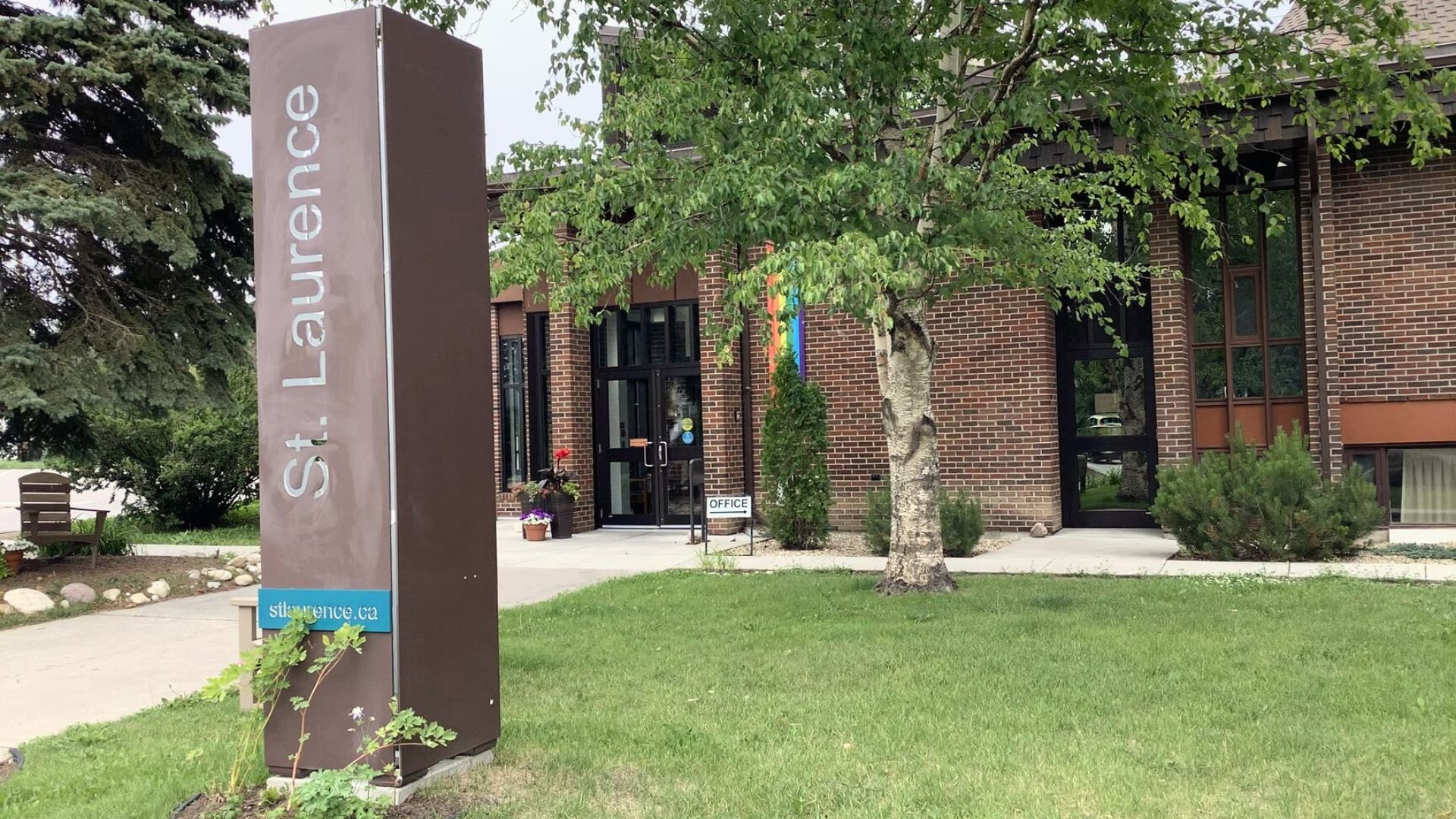
History of St. Laurence Anglican Church
The first glimmerings of St. Laurence Anglican Church began with the formation of a Sunday school in 1962 as a mission of St. Mark’s Church. It operated out of the previous Lakeview Community Hall, serving approximately 250 children. In 1963 plans were announced for a new Anglican Church to serve the community of Lakeview, with Bishop Calvert naming the new church after Saint Laurence. In 1964 it was moved to the Lakeview Elementary School’s gymnasium where the basketball hoop was allegedly the focal point of the worship. In addition to the Sunday school, two weekly services were conducted.
St. Laurence’s first Rector, former Army Chaplain Major Alex Wakeling, was hired in 1965. A local firm of architects provided the innovative and distinctive design for the building. Sod was turned for the new Church on September 17th, 1966. During construction, services were moved to a “portable” at Lakeview United Church. The portable was not insulated, and it was, during the winter, at times colder inside than out (to the point that the organ being used sometimes wouldn’t work!). On March 17th, 1967, the completed building was dedicated to the Glory of God at a service presided over by Bishop Calvert, and the congregation moved in.
With the completion of the physical plant came mortgage payments! This gave rise to many fundraising activities which became part of St. Laurence’s early traditions: an annual Fashion Show, featuring members of the congregation as models; the annual garage sale; Easter plant sales, in which members of the parish canvassed and delivered plants city-wide; a community Kindergarten (two classes worth!) run out of the Church Basement; a collection site in the parking lot for recycling newspapers; a ballet school; and, apparently, participation in inventory-taking at the Bay! With the passage of many years, in 1988 the mortgage was paid off, and on June 12th, 1988, Bishop Curtis performed the Dedication and Consecration Ceremony.
During the years since the construction of the building, we’ve witnessed many changes: landscaping was completed; the basement was finished and comfortably decorated; an organ was purchased; pews were installed; many special gifts were received which are utilized in our worship to this day; various groups, committees, work parties, activities, and productions (“Jesus Christ Superstar” was produced at the Church in 1971) came and went; help and funds were donated to many worthy causes; whilst all along, the choir and the style of service continued to evolve into what we experience today.
In early 2001, a Parish Renewal Survey was carried out, and a Visioning Group was established with its goal “to seek God’s will for the future of St. Laurence.” After several years of defining and refining the vision, a new “Vision for Ministry” was adopted at a special meeting of parishioners on June 22nd, 2005. It was determined that the Anglican parish of St. Laurence be called to create “an intentional community seeking to practice a renewed Christian spirituality in order to deepen our experience of God and share this path with others as a response to the growing hunger for meaning and hope in our community and our society.” (Wording credited to the Rev. Don McLeod) On August 1st, 2006, the Rev. Anna Greenwood-Lee began her tenure as the new Incumbent ready to lead the parish as a Practicing Congregation. Two significant developments occurred during her leadership: the launching of the Wisdom Centre on May 16th, 2007, and the renovation of the building in order to allow for increased accessibility and upgrades to the worship space. After closing the building for six months, the renovated St. Laurence welcomed parishioners back to its space just in time for Christmas services in December 2012.
We have been blessed with a succession of fine spiritual leaders over the years. Our history has certainly been one of hard work and careful stewardship by the people of St. Laurence. That spirit is reflected in the words of Rev. Anna when she wrote in 2013, “St. Laurence is a vibrant, welcoming and inclusive Anglican community. We love to ask questions, experiment with new things, and through the Wisdom Centre, contribute to the larger conversation about how to renew and revitalize Christian life in the 21st century.” May it always be so.
Our Building
St. Laurence has always been a close, tightly knit community congregation. This premise was a major factor in planning the church building. In a traditional church, the altar, sanctuary and communion rail face west, fronted by seats for the choir, followed by a long straight nave for the congregation. In this arrangement, the appearance of a gulf between the clergy and laity is created. A building in this form seriously prejudices the congregation’s view of all the important events taking place at the altar and in the sanctuary. This design was deemed by the planners not to be acceptable for our close family. We wanted to be more intimately involved with, and feel a part of, the liturgy.
Some of the thinking behind the resulting design was quite radical for the times (including a concept to use the sanctuary as a platform for productions of religious plays). The sanctuary was placed centrally so that the congregation could be grouped around it, thus becoming more involved with the service both visually and audibly. The narthex (the entryway into the church) has a low ceiling to instill a feeling of humility upon entering. As one proceeds further up the stairs into the body of the church, the space explodes into openness and light, and the sanctuary with the altar becomes a strong focal point. At St. Laurence no one sits more than 38 feet from the altar, and that brings us all closer as a family in worship. During services, we come forward to read lessons and give announcements, allowing us all to participate, all to see and all to hear, just as at a family gathering. Baptisms are carried out at the entrance to the sanctuary, rather than in the traditional and symbolic location in the narthex. The congregation welcomes the new members to the church and participates with them intimately in the service. An elevator added in the entryway in 2012 provides access for those with disabilities.
Our Namesake
Saint Laurence (or Lawrence) was a famous martyr of Rome who lived in the second century. He was one of seven deacons who were in charge of giving help to the poor and the needy. When a persecution broke out, Pope St. Sixtus II was condemned to death. As he was led to execution, Laurence followed him weeping. "Father, where are you going without your deacon?" "I am not leaving you, my son," answered the Pope. "In three days you will follow me." Full of joy, Laurence gave to the poor the rest of the money he had on hand. He even sold expensive church vessels to have more to give away. The prefect of Rome, a greedy man, thought the Church had a great fortune hidden away. Knowing that Laurence was the principal financial officer, the prefect promised to set him free if he would surrender the wealth of the Church. The saint said he would, in three days. Then he went throughout the city and gathered together all the poor and sick people supported by the Church. He showed them to the prefect and said: "This is the Church's treasure." The prefect was furious. In his anger he condemned Laurence to a slow, cruel death. The saint was tied on top of an iron grill over a slow fire that roasted him. God gave him so much strength and joy that Laurence, the legend goes, is said to have joked, "You may turn me over; I am done on this side," he said to the judge. Before he died, he prayed that the city of Rome might be converted to Jesus. He prayed that Christianity would spread all over the world.
Laurence died on August 10th, AD158, aged 32. His feast spread throughout Italy and northern Africa. Emperor Constantine built a beautiful basilica in Laurence's honour. St. Laurence is among the saints mentioned in the First Eucharistic Prayer at Mass.

Please consider supporting our mission.
St. Laurence Anglican Church relies on donations from our generous community to continue providing immersive worship and community services.


